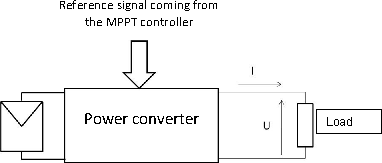2.5. Power converters
2.5.1. Introduction
Power electronics enables us to carry out, with the help of semiconductor elements operating as switches, the interface between two electrical “sources”. For instance, a photovoltaic generator made up of a cell assembly and a load, possibly including buffer storage or else an alternative source, in the case of an output on the electrical network, by ensuring (Figure 2.43):
– adjustment of some magnitudes (amplitude, frequency, phase);
– and/or a change of form of this source (alternative ⇔ continuous).
Figure 2.43. Power converter typology

In power electronic converters, semi-conductors operate in commutation (on-states and off-states), in order to obtain fundamentally high efficiencies. They are thus associated with filter elements (storage on the scale of the quenching period). In the following section we will present the main conversion structures used in the field of photovoltaic generation.
2.5.2. Structure of the photovoltaic conversion chains [PAN 04]
There are structures of inverters, which are directly connected to the network and others, which are magnetically decoupled from the network with the help of a transformer. In general, inverters have an average lifespan of 10 to 12 years.
2.5.2.1. Without an isolation transformer
The structure of Figure 2.44 is made up of an input capacity, only one converter (thus ensuring by itself ...
Get Electricity Production from Renewables Energies now with the O’Reilly learning platform.
O’Reilly members experience books, live events, courses curated by job role, and more from O’Reilly and nearly 200 top publishers.

